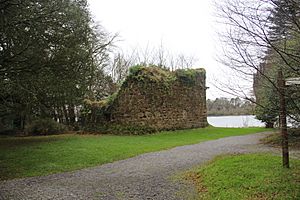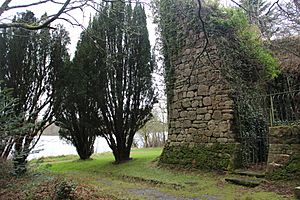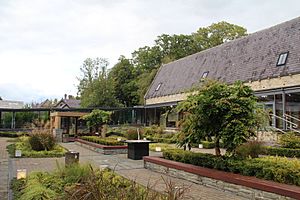Lough Rynn Castle facts for kids
Lough Rynn Castle (in Irish: Caisleán Loch na Reanna) is a beautiful castle hotel located by Rinn Lough in County Leitrim, Ireland. It stands on land that once belonged to the Mac Raghnaill family, who were important rulers in this area long ago. Today, it's a popular place for visitors to stay and explore the history and nature around it.
Contents
Where is Lough Rynn Castle?
Lough Rynn Castle and its large estate are found on a narrow strip of land between two lakes: Rinn Lough and Lough Erril. It's about 4 kilometers from the town of Mohill. If you're coming from Dublin, it's about 145 kilometers away, and from Galway, it's about 155 kilometers. The closest airport is Ireland West Airport Knock, which is about 99 kilometers from the castle.
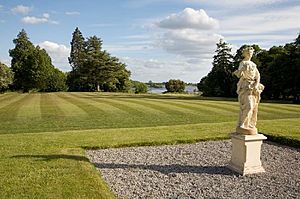
A Look Back in Time: The Castle's History
The Mac Raghnaill Family (Before 1621)
The land where Lough Rynn Castle now stands was originally owned by the Mac Raghnaill family. They were the rulers of this part of County Leitrim before the English took control of Ireland. Old records from 1247 mention a "crannóg" (an ancient island home) on Rinn Lough. A medieval castle belonging to the Mac Raghnaill family is also mentioned in 1474.
The ruins of this old Mac Raghnaill Castle are still visible near the lake, about 500 meters from the current Lough Rynn Castle. Historians say this old castle was square but had rounded corners, which made it stronger against attacks. It also had a unique straight staircase built inside a wall. The Mac Raghnaill family played a big part in the Nine Years War, fighting against the English.
The Crofton Family Takes Over (1621–1750)
In 1621, during the English Plantation of Ireland, the Mac Raghnaill family's lands at Lough Rynn were taken by the English government. These lands were then given to an English family called Crofton. The Croftons brought British Protestant settlers with them, and over time, the native Irish people were moved off the land.
The Clements Family Arrives (1750–1970s)
In 1750, the Crofton family was replaced by another English family, the Clements. Nathaniel Clements bought the Lough Rynn estate. The Clements family became more involved in the local politics of Leitrim. In 1795, Robert Clements became the first Earl of Leitrim. In 1833, Robert Bermingham, Viscount Clements, built a new house overlooking Rinn Lough. This house was designed to look like a Tudor-style building and is the foundation of the Lough Rynn Castle we see today.
William Sydney Clements, 3rd Earl of Leitrim
When Robert died in 1839, his brother, William Sydney Clements, took over the Lough Rynn estate. In 1854, William Sydney Clements became the 3rd Earl of Leitrim. He inherited a huge estate of 90,000 acres across four counties.
Sydney Clements was known for being very strict with his tenants. Many tenants struggled to pay rent, especially after the Great Famine. This led to him clearing some of his land to make way for more productive farming.
His actions made him very unpopular. In 1858, he tried to take back a local church because rent hadn't been paid. However, thousands of people gathered to defend the church, and Clements had to back down. Newspapers at the time noted that Lord Leitrim was "famous for such actions towards his tenants." By 1860, he had become a strong supporter of the Conservatives and was against calls for land reform. He even spoke out against the first Irish Land Act in 1870, which aimed to protect tenants.
Hatred towards Sydney Clements grew. In 1878, he evicted many tenants in Donegal who were suffering from a famine. On April 2, 1878, three men, Michael Heraghty, Michael McElwee, and Neil Sheils, killed William Sydney Clements near Milford, County Donegal. His death received a lot of attention, and many people used it to show the need for better protection for tenants from unfair landlords.
Expanding and Improving the Castle (1889)
After Sydney Clements' death, his cousin, Colonel Henry Theophilus Clements, inherited the Lough Rynn estate. Colonel Clements began a major project to expand and improve the castle. He added a new section and built a grand Baronial Hall with detailed plasterwork, a large fireplace, and walls covered in oak wood.
When it was finished in 1889, the main floor of the castle had a main hall, the Baronial Hall, a chapel, a reception room, a living room, and a dining room. There were also kitchens and storage areas. Upstairs, there were fourteen bedrooms and four bathrooms.
By 1952, when Marcus Clements took over the estate, most of the land had been sold to former tenants due to new land laws. Clements lived there until the 1970s. The estate was mostly empty until 1990 when an Irish-American investor, Michael Flaherty, bought it. In 2000, the Hanly family bought Lough Rynn estate. They invested a lot of money to update and modernize the house and grounds. In September 2006, Lough Rynn Castle opened as a hotel, with its estate covering three hundred acres.
Lough Rynn Castle Today: A Hotel
The Castle Hotel
Today, Lough Rynn Castle Hotel has forty-two bedrooms. It features the historic Baronial Hall, a library named after John McGahern, a drawing room, a piano room, and a bar. It also has the award-winning Sandstone restaurant. The hotel can host conferences, events, and weddings for up to three hundred guests in a special function room. The entire hotel is also accessible for wheelchairs.
Exploring the Gardens and Grounds
The estate is home to a four-hundred-year-old oak tree. You can also find a Bronze Age tomb called Cloch an Draoi ('Druid's Altar') on The Druid's Hill, dating back between 1900 BC and 300 BC.
The grounds also include old sawmills, a farmyard, an arboretum (a collection of trees), a greenhouse, French stable yards, and nature trails. There are two bridges over the Rynn river, which connects Lough Erril and Rinn Lough: the Red Bridge and the Blue Bridge.
A main walking path starts at the Castle. It goes past the 'Ha-ha wall' and the Blue Bridge. If you turn right, you'll pass the site of the ancient crannóg (island dwelling) in Rinn Lough as you walk towards the Boathouse.
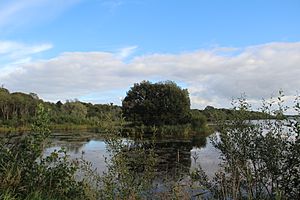
Beyond the Boathouse are the remains of the Mac Raghnaill medieval castle. If you turn left after the castle, you'll find the Rockery and Wishing Chair by the lake. Turning right along the shore leads to the back entrance of the estate's most impressive feature: the huge, three-tiered walled gardens that overlook the lake. These gardens were originally built between 1855 and 1860. When they reopened in 2008, they were the largest privately owned walled gardens in Ireland.
Images for kids


